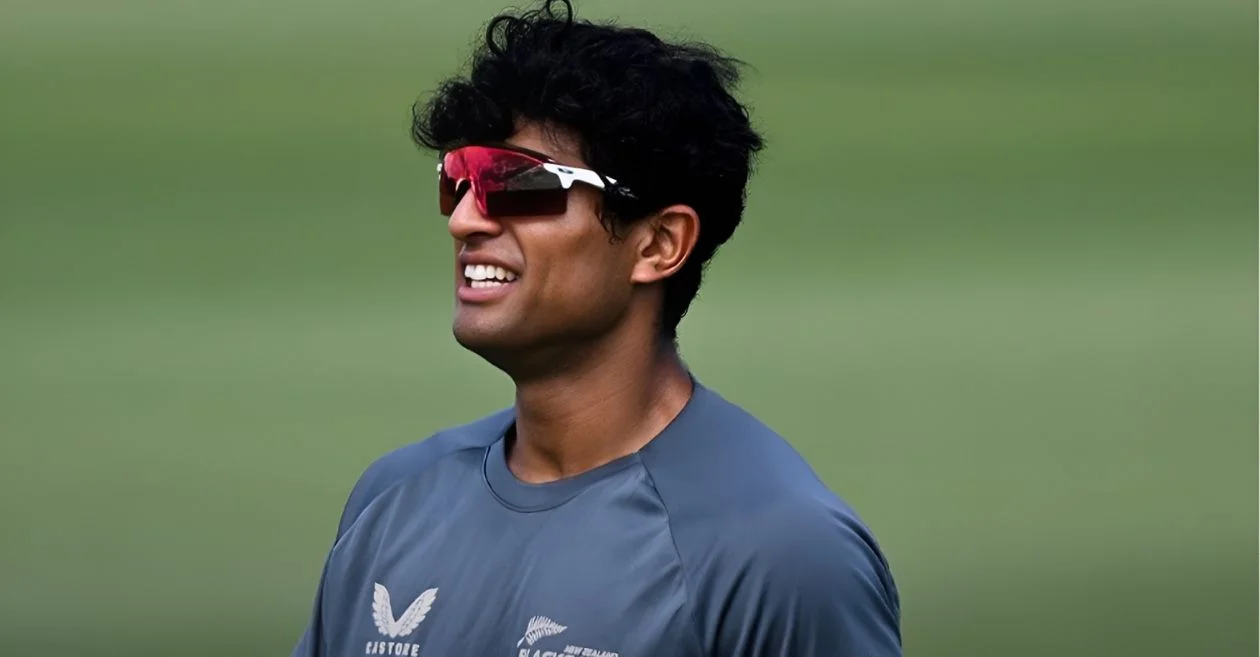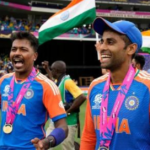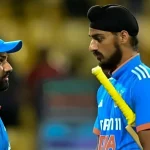The ongoing Trans-Tasman T20I series between New Zealand and Australia has taken an unexpected and significant turn, with the late withdrawal of star all-rounder Rachin Ravindra due to a severe facial laceration. The New Zealand camp, already struggling with injuries and player unavailability, has been forced to make last-minute adjustments ahead of what was expected to be a high-intensity, full-strength contest.
Ravindra’s absence is a substantial blow to the Black Caps, who are already missing several senior players. To address the gap, the squad has brought in seasoned all-rounder James Neesham, whose experience and versatility are expected to provide some stability. However, the cumulative effect of multiple absences has cast a shadow over the series, raising questions about New Zealand’s competitiveness and tactical depth.
Rachin Ravindra’s Injury: How It Happened
The incident that ruled Ravindra out of the series occurred during a fielding drill at the Bay Oval, where the young all-rounder collided with the boundary boards in a freak accident. The impact resulted in a deep laceration to his upper lip and nose, necessitating specialist stitching. While Ravindra initially cleared concussion protocols and seemed fit to continue, medical assessments concluded that the facial injury required rest and recovery, ruling him out of the three-match series against Australia.
Head coach Rob Walter expressed his disappointment, stating, “Rachin is a key part of our plans, but his health and recovery are our top priorities. This was an unfortunate incident, and we will focus on ensuring he returns fully fit for the upcoming home series against England.”
The timing of the injury could not be worse, coming at a critical juncture when New Zealand’s T20I squad is already stretched thin, forcing the management to quickly find replacements and reshuffle the team balance.
James Neesham Steps In
In response to Ravindra’s withdrawal, James Neesham has been called into the squad as a like-for-like replacement. The veteran all-rounder brings valuable experience, calm under pressure, and the ability to contribute both with the bat and ball, particularly in high-pressure situations where the team’s core players are absent.
Neesham’s inclusion provides several advantages:
-
Left-Handed Batting Option: His left-handed batting adds variety to the lineup and can counter specific Australian bowling strengths.
-
All-Round Skills: Neesham’s ability to contribute with medium pace or seam bowling offers tactical flexibility, especially with New Zealand’s bowling resources stretched.
-
Leadership and Experience: With multiple senior players missing, his presence in the dressing room offers guidance to younger players navigating their first major international exposure.
Although Neesham brings depth to the squad, he cannot fully offset the void left by Ravindra and other missing senior players. The Black Caps will rely heavily on newer and less experienced members of the squad, making this series an important opportunity for them to prove their mettle under challenging circumstances.
New Zealand’s Injury Crisis
Ravindra’s withdrawal highlights the extent of New Zealand’s personnel crisis, which has already severely hampered preparations and limited tactical options. Among the notable absences:
-
Kane Williamson: The regular T20 captain is unavailable, forcing captain Michael Bracewell to lead a significantly weakened side.
-
Mitchell Santner: The team’s premier all-rounder is sidelined due to an abdominal injury, leaving a gap in both spin and batting depth.
-
Glenn Phillips: Key middle-order power hitter unavailable due to a groin injury.
-
Finn Allen: Another experienced top-order batter ruled out with a foot injury.
-
Adam Milne and Lockie Ferguson: Frontline pacers hampered by ankle and hamstring issues respectively.
This combination of absences leaves New Zealand reliant on a mix of relatively inexperienced players and veterans adjusting to unfamiliar roles. The team’s balance, especially in the all-rounder and bowling departments, is under considerable strain.
Australia’s Challenges
Australia, too, is facing injury setbacks, although the scale is less severe. Missing from the lineup are Glenn Maxwell and Josh Inglis, who were expected to play pivotal roles in the batting order. Their absence affects Australia’s flexibility in the middle order and power-hitting options but does not completely destabilize the squad.
While both teams are missing key players, New Zealand’s situation is notably more critical, with the number and experience of absent personnel far higher. This imbalance has inevitably impacted expectations and raised concerns about the competitiveness and intensity of the series.
The Trans-Tasman Series: What It Means
Originally billed as a thrilling contest between two of the strongest T20 sides in the world, the series has now lost some of its anticipated glamour due to the absence of multiple marquee players.
For New Zealand:
-
Pressure on New Leadership: Captain Michael Bracewell must now navigate the series with a team largely deprived of senior leadership, requiring tactical ingenuity and calm under pressure.
-
Opportunity for Young Talent: Despite challenges, the series offers a chance for emerging players to gain exposure at the international level and demonstrate their capability on a global stage.
-
Bowling Adjustments: With frontline pacers and key spinners absent, the team must rely on depth options and strategic field placements to control the opposition’s scoring.
For Australia:
-
Maintaining Edge: The visitors will look to leverage New Zealand’s weakened lineup to consolidate their strength in T20Is ahead of major upcoming tournaments.
-
Team Strategy: Australia’s mix of experienced and bench players must ensure stability in batting while exploiting gaps in New Zealand’s bowling attack.
While the series may not feature all first-choice lineups, it still presents a test of adaptability and resilience for both sides, reflecting how cricket teams must cope with unforeseen circumstances in international tours.
Tactical Implications
Rachin Ravindra’s absence and the broader injury situation have significant tactical implications:
-
Batting Depth: With key middle-order batters unavailable, New Zealand may need to promote younger players or adjust the batting order to maintain momentum in chases or set competitive totals.
-
Bowling Adjustments: Ravindra’s left-arm spin and batting were crucial for variety; replacing him with Neesham provides batting depth but less spin variation, potentially placing additional pressure on remaining bowlers.
-
Fielding Responsibilities: Ravindra’s fielding was a key asset; his absence may slightly reduce New Zealand’s agility in critical positions, impacting run-saving opportunities and catching potential.
-
Team Morale: Continuous withdrawals may affect team confidence, especially when inexperienced players are thrust into high-stakes scenarios against a formidable Australian side.
Fans’ and Experts’ Reactions
The cricketing community has responded with a mix of disappointment and empathy. Fans on social media expressed their frustration over missing marquee players but praised New Zealand’s decision to prioritize Ravindra’s health. Experts have highlighted the following:
-
Health Over Competition: Player safety remains paramount, particularly in high-contact sports where long-term health can be compromised.
-
Neesham’s Inclusion: Analysts believe Neesham’s experience will help steady the side and provide a template for younger players.
-
Impact on Series Quality: There is acknowledgment that missing multiple stars inevitably affects the spectacle, though it also opens avenues for unexpected heroes to emerge.
Looking Ahead
Despite the setbacks, New Zealand will aim to salvage pride and competitiveness in the series. The next matches will test:
-
Captaincy and Strategy: Bracewell’s leadership will be under scrutiny as he manages inexperienced players and rebalances the team dynamically.
-
Emerging Talent: Players stepping into first-time international roles may use this opportunity to stake a claim for regular selection.
-
Resilience Under Pressure: Maintaining composure and executing plans under challenging circumstances will be critical, particularly against a strong Australian outfit.
For Australia, the priority remains to maintain dominance and integrate players like Josh Inglis’ replacements effectively, ensuring continuity in performance even with their own injury challenges.
Broader Context: Injuries and Modern Cricket
Rachin Ravindra’s injury is a stark reminder of how modern cricket schedules, training intensities, and match pressures can impact player availability. Teams today often face the challenge of managing fitness, recovery, and peak performance amidst packed international calendars.
Key takeaways include:
-
Importance of Squad Depth: Teams must have capable replacements ready to step in seamlessly, as seen with Neesham’s call-up.
-
Flexibility in Roles: Players must adapt to new responsibilities in response to injuries, emphasizing versatility in contemporary cricket.
-
Focus on Player Welfare: Injuries like Ravindra’s underline the necessity of prioritizing health, even if it means missing high-profile series.
Rachin Ravindra’s unfortunate withdrawal from the New Zealand T20I squad is a significant setback for the Black Caps in their series against Australia. While the inclusion of James Neesham provides some stability, the cumulative absence of several senior players leaves New Zealand heavily reliant on emerging talent and tactical adaptability.
The series, though diminished in star power, now offers a compelling narrative of resilience, opportunity, and leadership under pressure. Young players have a chance to make their mark, and veterans like Neesham and Bracewell must guide the team through this turbulent phase.
As both sides navigate injuries and reshuffled lineups, the Trans-Tasman rivalry continues, albeit in a format that tests depth and adaptability more than raw star power. Cricket fans will be watching closely, not just for the result, but to witness how a team reinvents itself amidst adversity.
While the Black Caps hope to recover their full strength soon, the current series serves as a case study in the unpredictability of international cricket, where injuries and last-minute withdrawals can redefine strategy, opportunity, and the very narrative of a contest.
Please check for information on the best betting sites in India – https://selectory.org/best-betting-sites/















